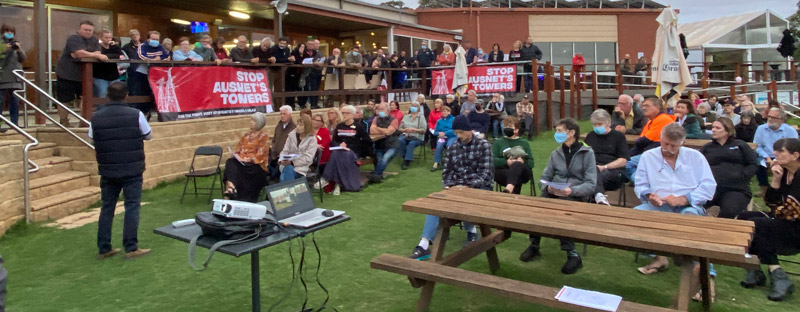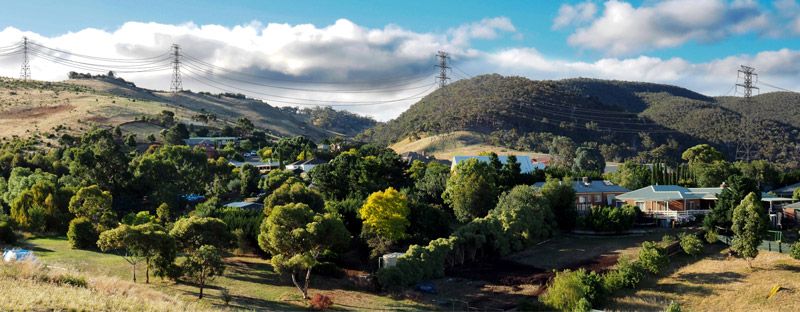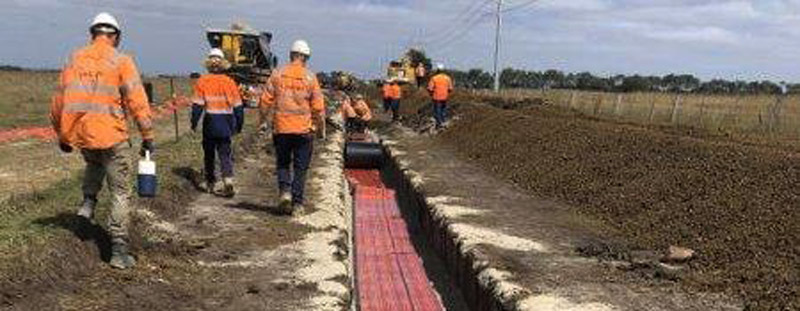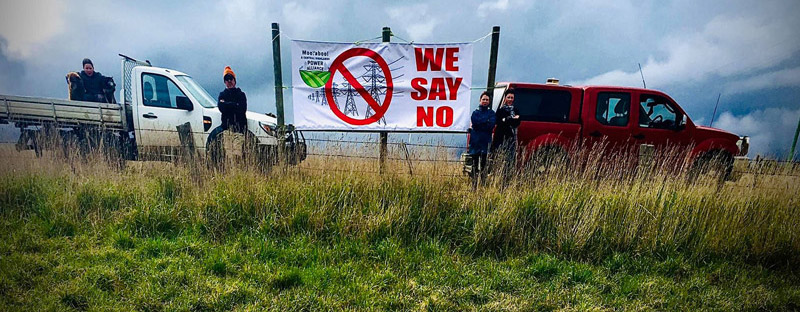Stop AusNet’s Towers Newsletter – February 2021
Newsletter Welcome
Welcome to the new look “Stop Ausnet’s Towers” Newsletter. This Newsletter is dedicated to providing information on the impacts of the Western Victoria Transmission Network Project (WVTNP), on behalf of the Moorabool Central Highlands Power Alliance’s (MCHPA) campaign, “Stop AusNet’s Towers” and will also offer ways in which the community can support the campaign.
The MCHPA was formed last year to advocate on behalf of residents, landowners, businesses, and community groups concerned about the impacts of the WVTNP on our lives, properties, environment, community, economy, and future.
As part of the WVTNP, AusNet wants to build 380 transmission towers each up to 80 metres tall and associated high-voltage lines connecting Bulgana, near Ararat, to Sydenham, in Melbourne’s West. For perspective, the smallest transmission towers will be the height of the West Gate Bridge; the largest taller than the MCG’s light towers.
There is also a large Terminal Station proposed to be built North of Ballarat and at around 19 to 24 ha in site coverage, its footprint will be 10 – 12 times the size of the MCG playing field.
MCHPA is well-organized grassroots, member funded community group backed by specialized legal, technical and campaign professionals who rely on the unified support of the community.
We believe there are numerous options that Ausnet may undertake to avoid these impacts. We are here to support you and in turn we need you to support the Campaign.

Darley Community Information Session
On Monday February 8th over 200 concerned residents from Darley, Coimadai and surrounding areas attended a Community Information Session hosted by MCHPA at the Bacchus Marsh Golf Club in Darley.
This information session was an opportunity for the community to gain a deeper insight into the proposed Western Victoria Transmission Network Project (WVTNP), and importantly how the community may assist in campaigning to “Stop AusNet’s Towers”.
The proposed towers are going to have an enormous and detrimental impact on the landscape, community, local business and the environment. The following key concerns with regard to impacts of the WVTNP were raised throughout the session:
- Visual impact and subsequent decrease in property values – a conservative estimated drop of 30-50% is to be expected. This will result in reduced landholder’s equity and access to finance and will in turn reduce Council rate income and associated services.
- Environmental impact resulting in an increased threat to native animal habitats and endangered species as well as impact several State and National Parks and for you the Lerderderg Gorge.
- Increased Fire Threat. This Project will increase the risk of catastrophic bushfires and reduce the ability of the CFA to fight bushfires in what is already a high fire danger region.
It was noted there are many other community concerns associated with the towers.
The MCHPA presented suitable alternatives that have not been explored by the WVTNP’s nor by AEMO (Australian Energy Market Operator). This information was well received by those in attendance.
At the conclusion of the Presentation questions and concerns were raised as to how this project will have a direct effect on individuals, specifically on their property value and quality of life. Community members expressed their numerous concerns with the project and the profound negative impact of the proposed towers. Of particular note throughout the session Community members demonstrated a keen appetite to lobbying against the proposed towers.
We look forward to continuing with this level of Community engagement.

Environmental Effects Statement (EES) Overview and Update
The EES process is a systematic environmental assessment framework for projects with the potential for significant environmental impacts. The Ministerial Guidelines for assessment of environmental effects under the Environment Effects Act 1978, set out the processes and requirements for an EES and explains that the ‘proponent’, which in this case is AusNet, is required to carry out a thorough analysis of potential effects of the project on the ‘environment’ which is defined in the Guidelines as ‘the physical, biological, heritage, cultural, social, health, safety and economic aspects of human surroundings, including the wider ecological and physical systems within which humans live’.
In his Reasons for Decision for requiring an EES, the Minister for Planning, Richard Wynne said that:
An EES process will provide a robust, transparent and integrated framework through which:
- the project’s potential environmental effects can be rigorously assessed, including in the context of the comparative effects of feasible siting, alignment, design and operational alternatives for key components of the project; and
- the effectiveness and acceptability of proposed measures to avoid, minimise, manage and offset environmental effects and related risks can be evaluated/examined.
The Impact Assessment Unit, Statutory Planning Services, at the Department for Environment, Land, Water and Planning (DELWP) coordinates the EES process in accordance with the Ministerial Guidelines and in conjunction with a Technical Reference Group containing members from government agencies, and local government and other statutory authorities, as well as registered Aboriginal parties.
It is important to know that the EES is not an approval process in itself but produces an extensive range of reports that, along with a formal public hearing which might last for many weeks, help statutory decision-makers (e.g. Ministers, local government and statutory authorities) to determine whether a project with potentially significant environmental effects should proceed as proposed, or with modifications, or be refused.
The EES process is clearly and visually laid out to show the specific stages in this one-page summary How does the EES process work?
The process also provides opportunities for public feedback at different stages. We have already all had a chance to make submissions to the Draft Scoping Requirements, which set out the specific matters to be investigated and documented in the EES. Overall, 106 submissions were received by DELWP, all of which will have been passed on to AusNet.
There weren’t many changes made to the Draft Scoping Requirements when they were finalised, but this is typical for all EES projects, and not just this one. There were, however, stronger requirements added for AusNet to ‘avoid’ impacts as their first response, not to just minimise them, and to more fully demonstrate how they have considered feasible alternatives including providing their rationale for their ‘preferred’ mode of construction (overhead or underground) and explaining their criteria for evaluating the feasibility of potential alternatives. See the Final Scoping Requirements Frequently Asked Questions (FAQs) for more information about how the Draft document was finalised.
DELWP, AusNet, MP Richard Wynne, MP Angus Taylor & MP Lily D’Ambrosio are now fully aware that there is significant opposition to this project, in its present form. Local communities are very protective and invested in their social, cultural and physical environments and will not tolerate an inadequate or ill prepared ‘tick the box’ EES investigation and submission from AusNet.
And while AusNet is meant to ‘consult’ with us throughout the EES process over the next 1½ years (they say they will be finished mid-2022) we won’t hold our breath on that happening with much care or concern – it hasn’t happened to date, and they haven’t even given DELWP the Consultation Plan that they are meant to have already produced. But over the entire length of time that it takes AusNet to do their EES, we will keep letting DELWP know what they have, or haven’t been doing, in their ‘consultations’.
In mid-2022, when AusNet finishes the EES and all their reports are made public, we will all have the opportunity to read them, make written submissions, and appear at the formal hearing if we request to be heard. The MCHPA wants to make a serious and detailed submission at that time and to do that we will need to bring a number of experts on board under expert legal guidance.
We have recently briefed a very experienced Environment and Planning legal firm to instruct a barrister to provide guidance on the experts we should focus on engaging sooner rather than later so that we don’t miss out on getting the best experts we can. As well as also needing to also engage this barrister for the formal enquiry, experts are most likely to be needed for the following issues – undergrounding technology (see the article in this Newsletter), bushfire risks, economic impacts (on agriculture, land values, tourism, other businesses etc), impacts on landscape and visual amenity, and an expert planner to wrap it all up. To do this we are going to need to do some serious fundraising. We will provide more information on this in later Newsletters and we hope we can count on your support.

A Case for Undergrounding
Jim Phasey, on behalf of the MCHPA’s Technical Working Group
Coming from an engineering background, I am frustrated by what I see as such a poor design solution being imposed upon us, which disregards the extra risk to the environment and the community, and I am disappointed because I believe that Australia is a smart country and I know we can do better.
So far, AusNet and the AEMO have pushed the benefits of an overhead High Voltage Alternating Current (HVAC) solution, while they have dismissed other options like High Voltage Direct Current and undergrounding on the basis of technical feasibility, cost, and by saying that undergrounding is worse than overhead for the environment.
These generalisations are wrong, and they are misleading.
Murraylink
To prove my point, the Murraylink interconnector is an Australian underground transmission project which is both technically and economically feasible. It ships power efficiently underground for 177 km between Redcliffs, Vic, and Berri in SA.
And in fact, this underground High Voltage DC cable won an Environmental Excellence award in 2002 for best practice and innovation in environmental management. It did not damage the environment as AusNet suggests. I have spoken with the project engineer for Murraylink and he told me that while there was initial ground disturbance to bury the cable, in the whole 177km they only removed one tree!
The Murraylink design used existing rights of way along roadsides to minimise the environmental impact, and only required an easement of 6m wide, not 60 – 100m for overhead. It used horizontal direct drilling to get the cable under sensitive heritage sites and environmentally significant areas, and roadways, rather than digging through them. It even drilled under the Murray River.
Marinus Link
In addition, to provide another example, the Marinus Link is a new project being proposed by AEMO for a second transmission link from Victoria to Tasmania. This is being proposed as an undersea High Voltage DC cable. This is understandable, because you can’t use towers to get to Tasmania, but what is significant for us here in Moorabool is that the Victorian portion of the project, which is 90 km in total in Gippsland, from the beach to Hazelwood, is going to be an underground High Voltage DC cable.
For the Marinus Link, which is only 230 kms from here, on the other side of Melbourne, the business case determined it would be more cost effective and technically feasible to continue with DC and to put it underground, rather than going overhead.
HVAC vs HVDC alternate
The fundamental reason that these projects are able to efficiently and economically achieve long distances underground, is because they use Direct Current (DC), rather than alternating current (AC).
We agree with AusNet that there are challenges with undergrounding AC – but we don’t want AC, we never did, we want underground High Voltage DC.
What AusNet has not explained, is that while High Voltage AC is feasible for overhead power transmission, it is not technically feasible to put this underground for more than 35 – 70 km. In simple terms this is because the ground naturally ‘absorbs’ some of the power along the way and consequently, over a distance, less and less power remains available for the load. At some point, there will be no power left.
On the other hand, this limitation does not exist when you put High Voltage DC underground. DC is not absorbed anywhere near as much as AC, and therefore the power loss is much lower, allowing for the transfer of electricity over much longer distances very efficiently.
The case for the HVDC underground alternate:
So, because you don’t need towers for underground High Voltage DC, the straight-line distance is not critical, therefore undergrounding can use existing easements and rights of way along roads and highways, etc. This therefore minimises environmental and community impact and speeds up project delivery and reduces cost.
In addition, with the evolution in technology that have occurred since Murraylink, integration of HVDC into existing networks actually provides a range of other advantages such improving the stability of the existing power networks and facilitating the integration of renewable energy.
Furthermore, undergrounding HVDC reduces the overall level of risk we face. To list just a few of the benefits, it eliminates the chance of damage and costly power outages from extreme weather events such as at Cressy Vic, in January last year when six towers blew down.
It reduces the risk of high voltage lines starting bushfires, and avoids power having to be switched off during bushfires…
…and it does not interfere with agricultural operations or impose as many restrictions upon landowners whose properties are subject to easements. It does significantly not lower property values, destroy the visual amenity of the countryside, or negatively affect economic development or tourism opportunities.
The Final Pitch
So, because we understand the difference between AC and DC, and the benefits of undergrounding, and because we know of these real underground Australian High Voltage DC examples, and many more overseas, the MCHPA is arguing that the AEMO should stop the current project and properly investigate an underground High Voltage DC solution.
At this stage of the project, AusNet is only undertaking the design work, with construction and delivery requiring a favourable EES decision and other approvals.
Before this occurs, we want to convince Lily D’Ambrosio, the Victorian Minister for Energy and the Environment, and Richard Wynne, the Minister for Planning, and the AEMO that an alternate underground High Voltage DC solution is feasible, and that it would provide a greater overall benefit to Victorians.
Key to this is gaining an independent expert assessment of the appropriateness of an underground High Voltage DC solution, to challenge the AEMO’s assertions in public, in the EES, and in the courts.
To do this we have identified a creditable independent Australian specialist power transmission engineering consultant that has substantial industry experience, and the demonstrated capability to deliver us a report.
This company has Australian and global expertise in delivering leading High Voltage DC technology and undergrounding designs and implementations, and the Director was the principal engineer on the Murraylink project.
In scoping the study with them, this company has validated our above mentioned assetations – and we would now like to engage them to present their expert assessment of an alternate underground High Voltage DC solution for the WVTNP.
We have obtained a quote from them to do the study and it will cost in the order of $42,000 for this, and then more for the authors to appear subsequently as expert witnesses. It’s a big amount, but we think this is reasonable and necessary to get the calibre and credibility of the assessment, and we hope for all the support that you and others can give, thank you.
Produced by the Moorabool and Central Highlands Power Alliance

ABOUT US
Stop Labor’s Towers is demanding better consultation and a genuine process to consider alternatives.
The Regional Victoria Power Alliance comprises landowners, residents and community group concerned about the impacts of this project on our lives, land, environment, community and future generations.
